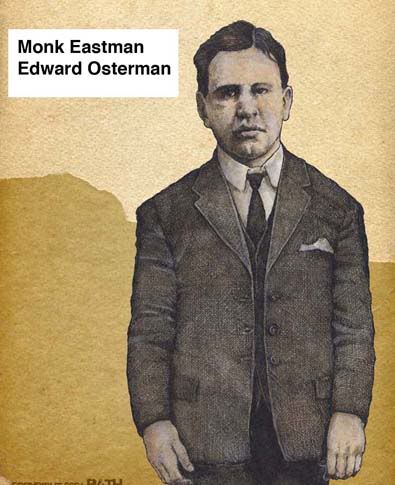
You wouldn't want to mess with Monk. Image by Pat Hamou. Pat has a great mobster site six for five and he sells his art work, very reasonably, on etsy

There's another story about Monk and the Silver Dollar Hotel/Saloon over at the Lower East Side History Project
Monk Eastman, aka: Joseph Morris, William Delaney, Edward Delaney, etc., was born around 1873 in Brooklyn under the name of Edward Osterman. His parents were respectable Jewish restaurateurs and set Edward up with a pet store on Penn street, near their restaurant. Edward grew bored and soon abandoned his store for the excitement of street life, gangsters, prostitutes, stuss games and all of the ilk associated with it. However, Monk (Edward) always held an extreme fondness for cats and birds and he later opened up a pet store on Broome street. Monk trained a pigeon to sit on his shoulder while he went about his street travels and sometimes carried a cat with him. This "sensitive" trait contrasted sharply with his fondness for backjacking assignments and other violent deeds. Monk boasted that he had never struck a women with his club or killed one. When a lady suffered a severe lapse in manners, he blackened her eyes.
"I only give her a little poke, just enough to put a shanty on her glimmer. But I always takes off me knucks first."
Around 1895, Monk moved to lower Manhattan and established himself as Sheriff of New Irving Hall. The "Sheriffs" acted as armed bouncers and were responsible for keeping order (of sorts) in the social clubs or resorts that were frequented and owned by gangsters/politicians. Monk developed a patois of clipped, slangy speech and an indifferent dress style. The artist's rendition of Monk shows him at his best, usually only when he was before a magistrate. Monk became very popular with the hoodlums of the East Side and they began to imitate his slang and sloppy clothes. Monk's outfit usually consisted of a derby hat several sizes too small, a blackjack tucked into his pants, open shirt, and brass knuckles adorning each hand. He carried a large club and enjoyed using it, "sending so many men to Bellevue Hospital's accident ward that ambulance drivers referred to it as the Eastman Pavilion."
After a few years, Monk quit his position as Sheriff of New Irving and moved up the crime ladder towards gang leader. Monk had established his kingdom by 1900 with more than twelve hundred warriors under the Eastman banner. The Eastman headquarters was a dive on Chrystie street, near the bowery, where they stockpiled slung-shots, revolvers, blackjacks, brass knuckles, and other tools of gang warfare. Their main sources of income were derived from houses of prostitution, stuss games (a form of faro), political engagements, blackjacking services, and the operations of pickpockets, footpads, and loft burglars. Tammany Hall, the political power in New York City, frequently engaged the services of Eastman to bring in the votes at election time. In return, Tammany Hall lawyers bailed Eastman out whenever he got arrested.
Monk Eastman's feud with Paul Kelly began over a strip of territory between Mike Salter's dive on Pell street and the Bowery. Eastman claimed domain over the territory from Monroe to Fourteenth streets and from the Bowery to the East River. Paul Kelly and his Five Pointers believed that their kingdom included the Bowery and any spoils found in this area. Eventually, the constant feuding would cause the downfall of both Monk Eastman and Paul Kelly.


























No comments:
Post a Comment